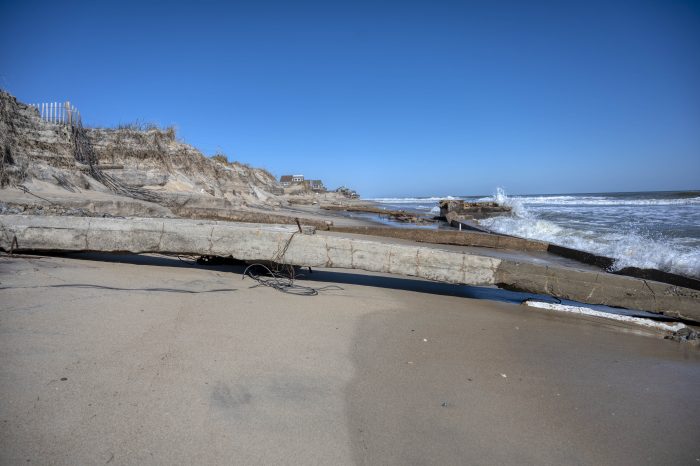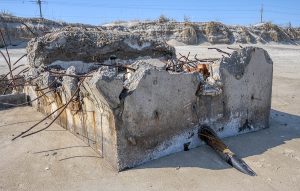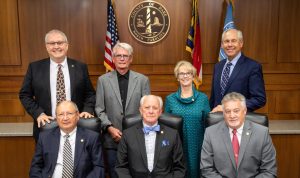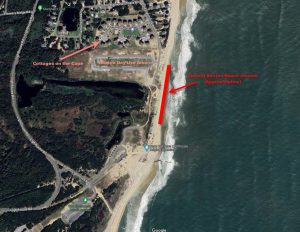Dare County Board of Commissioners take a united front on the issue of Buxton Beach

At the March 4 meeting of the Dare County Board of Commissioners (BOC), Hatteras Island Commissioner Danny Couch presented a resolution for the seven-member BOC to create a united and vocal front for the remediation efforts required to fix the environmental issues at Buxton Beach.
Couch’s resolution was presented during the BOC’s individual commissioner’s business portion of the meeting, which can be viewed online on Dare County’s YouTube page.
The resolution, which was passed unanimously by the BOC, gives county officials extra foundational heft for upcoming meetings with state and federal officials in the immediate future, which includes Washington, D.C. meetings scheduled for the end of March.

“Dare County is limited on its authority to act on this,” said Couch after the BOC meeting, referring to the county’s involvement in entangling with the massive clean-up efforts needed within a small stretch of the Cape Hatteras National Seashore.
“But this is an approved FUDS site, with the Navy and the United States Coast Guard being there for a number of years… We’re just trying to get everyone in a room, and emerging as one.”
The county’s recently passed resolution will be sent to the U.S. Environmental Protection Agency (EPA), the National Park Service (NPS), and the many state and federal agencies that are somehow linked to the ongoing issue.
“This will be one of the things that is front and center when we meet in D.C.,” said Couch. “The purpose of the resolution is to let people know that, with our hospitality economy and our reputation as the number five beach in the United States, this issue can’t be ignored.”
Petroleum infiltration and exposed infrastructure along Buxton Beach has been a decades-long nuisance.
4,000 tons of petroleum-contaminated sediment were removed from the area prior to 2005, as a result of more than three decades of former military activities at the approximately 50-acre site.
But the buried environmental mess resurfaced after two offshore hurricanes brushed the Outer Banks in August and September 2023, which caused a wave of new fuel smells and visible public safety issues.
 Though efforts were made in the 1990s and 2000s by the U.S. Army Corps of Engineers (USACE) to address the problem, these efforts were not 100% successful, according to recent scrutiny by the on-the-ground organizations and stakeholders involved.
Though efforts were made in the 1990s and 2000s by the U.S. Army Corps of Engineers (USACE) to address the problem, these efforts were not 100% successful, according to recent scrutiny by the on-the-ground organizations and stakeholders involved.
“Did the Navy have fuel spills here? Yes. Did the Navy have above and below-ground fuel tanks here? Yes. Did the Corps try to remove fuel here? Yes. Did the Corps’ reports say they removed all the fuel here? No,” said National Parks of Eastern North Carolina Superintendent, David Hallac, in an earlier interview.
“There appears to be a weight of evidence that this is connected to that [naval] site and the historic contamination,” said Hallac. “For decades, they have been performing remediation contamination. It seems like more work is necessary to complete the job.”
At Monday’s BOC meeting, Couch detailed why the issue of a 400-yard stretch of Buxton shoreline warranted a unified resolution.
“This is very concerning,” he said. “Not just from an environmental standpoint, but from a public safety standpoint as well.”
 “As a lot of people on the Board and the community know, from 1956 to 1982… the United States Navy operated a submarine tracking station right there under the shadow of the [Cape Hatteras] Lighthouse. And the original agreement with the National Park Service was that when the Navy bailed, they would restore the area to its original condition.
“As a lot of people on the Board and the community know, from 1956 to 1982… the United States Navy operated a submarine tracking station right there under the shadow of the [Cape Hatteras] Lighthouse. And the original agreement with the National Park Service was that when the Navy bailed, they would restore the area to its original condition.
“It was turned over to the Coast Guard [in 1986], and somewhere in that transition, it did not get cleaned up fully.”
During the meeting, Couch outlined multiple reasons why Buxton Beach needed to be at the forefront of the county’s attention.
“It’s not a good look for a National Seashore to have houses falling in one section, and to have crime tape around what is essentially [one of the best beaches] in the United States, according to Dr. Steven Leatherman, who goes by the name Dr. Beach.”
Like Hallac, Couch noted that the U.S. Army Corps of Engineers conducted years of efforts to remove as much abandoned infrastructure and residual petroleum as possible, but the work wasn’t completed just yet.
“They did not finish the job,” he said. “They’ve been called back out. And now they’re saying that they cannot find the source,” he said, referencing a photo of the original terminal building where recent NPS reports have indicated a fuel smell coming out of a 1-3” diameter pipe in the immediate area.
“Folks, there’s one source right there.”

Couch also noted that while a section of shoreline had been closed to the public since September 2023, footprints flourished in the area, and there was no way to prevent vacationers from curiously exploring the closed beach.
“When the water table comes up, when the ocean comes up, you can smell the fuel there,” said Couch.
“You’ve got surfers who are rashed. You’ve got kids who are in there playing around – I don’t care how much crime tape and how many signs there are that say ‘Keep Out’… They’re going to enter.”
Couch was paused in his presentation by Commissioner Rob Ross ahead of the lunch break, but the BOC had enough information to proceed. The resolution, which can be viewed in full here, was passed unanimously.
“I’m just curious if this exact scenario had washed up on the beaches of, I don’t know, Martha’s Vineyard or the Hamptons on Long Island. Would we still be begging and pleading for someone to please remediate this dangerous and unhealthy situation?” Commissioner Ross asked.
“The public is aware,” said BOC Chairman Bob Woodard. “We – the Vice Chair [Wally Overman], myself, and the county manager [Bobby Outten] are heading to D.C., and this will be one of our top subject matters when we meet with our legislators.”
For more information on the Buxton Beach issues, click here.












